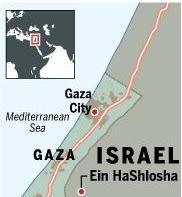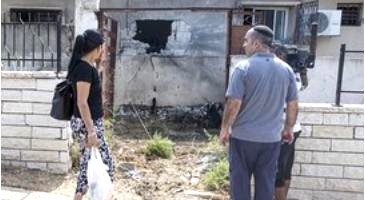Kibbutzim anger building against the Israeli government and military
.
Will public feeling intensify and stop the military action?
.
John Reed writes from Ein HaShlosha, a kibbutz in Southern Israel.
 Ein HaShlosha is one of several border communities that have been on the front line in Israel’s military operation against Hamas and have suffered from its ground invasion of Gaza and the incoming mortars and rockets fired from the other side.
Ein HaShlosha is one of several border communities that have been on the front line in Israel’s military operation against Hamas and have suffered from its ground invasion of Gaza and the incoming mortars and rockets fired from the other side.
They have no protection from the Iron Dome missile defence system. The community was shocked shortly after the ground war started, when Hamas fighters emerged from a tunnel in a field 1.5km away and clashed with IDF soldiers, leaving one Palestinian and two Israelis dead.
The damage in Israel’s south is, however, minimal when compared with the deaths and destruction in Gaza, where large urban areas are in ruins and tens of thousands of residents have fled rural areas ahead of the IDF, with untended crops left to rot and animals left to starve.
Operation Protective Edge
 Thousands of people have left the area since Operation Protective Edge began on July 7, but some have stayed to keep their businesses going. At Ein HaShlosha, where there is a a factory making ring binders and a dairy, some started to wear flak jackets when milking. The kibbutz is so near Gaza that residents have only 15 seconds to take cover when an alarm sounds. The communities are counting the mounting damage:
Thousands of people have left the area since Operation Protective Edge began on July 7, but some have stayed to keep their businesses going. At Ein HaShlosha, where there is a a factory making ring binders and a dairy, some started to wear flak jackets when milking. The kibbutz is so near Gaza that residents have only 15 seconds to take cover when an alarm sounds. The communities are counting the mounting damage:
- lost working hours
- and export contracts,
- crops flattened
- irrigation pipes crumpled under military vehicles,
- and houses and buildings that took direct hits from incoming fire.
Benjamin Netanyahu’s government has labelled this as a military ‘operation’ – not a war – to avoid payng full compensation to southern residents for their losses, though a number of of tax breaks and subsidies have been given to southern communities.
The backlash
Dani Cohen, the head of the kibbutz’s emergency team said, “It was a catastrophe, the way the army handled this operation – fighting, then ceasefire. This left people not knowing what would happen to them.”
Benny Gantz, the Israel Defence Forces’ chief of staff, was widely criticised by Israelis in the south after telling them it was safe to return home during an earlier ceasefire which broke down when Hamas refused to extend the ceasefire and Islamic Jihad and other Gaza militants fired rockets and mortars into the south.
The backlash against the military operation inside Israel, though limited, is a rare in a conflict in which most Israelis support their government. Though on July 22nd we recorded that in Tel Aviv, about 250 Jewish peace protesters were punched and pushed by a well-organised group of rightwingers in an attack that left several people with bruises, black eyes, or other injuries. Another, which mustered about 1,000 people, was attacked by rightwing activists, who threw eggs and plastic bottles.
A large demonstration is planned in Tel Aviv today to express support for beleaguered southern communities . . . Thousands of Gaza border residents are expected to attend the rally, bussed to Tel Aviv in transport organized by their regional council heads. Will some spare a thought for the far greater suffering of the Gazans?
–
Posted on August 14, 2014, in Countries under pressure and tagged Ein HaShlosha, Gaza, Hams, Iron Dome, Kibbutz, Operation Protective Edge, Southern Israel., Tel Aviv. Bookmark the permalink. Leave a comment.

Leave a comment
Comments 0